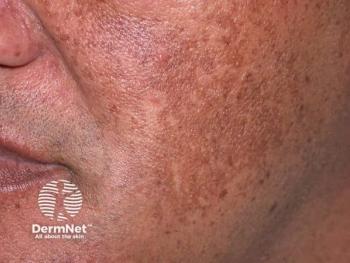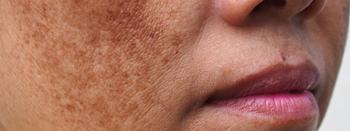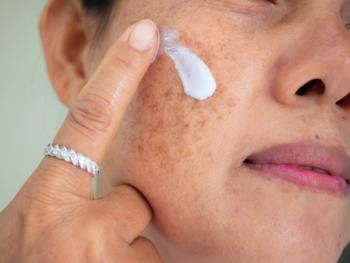
- Dermatology Times, June 2020 (Vol. 41, No. 6)
- Volume 41
- Issue 6
The power of a peel
Chemical peels offer important advantages for treating melasma. Researchers offer insights from a review of recent advances in chemical peel treatments in melasma and acne.
By applying one or more chemical ablative agents, dermatologists induce keratolysis or keratocoagulation on the skin’s surface. Patients often see a significant improvement in the skin’s appearance and texture after the first treatment.
In their review of recent advances in chemical peel treatments in melasma and acne, the authors report superficial peeling, affecting the epidermis to papillary dermis, primarily addresses melasma, dyschromia, post-inflammatory hyperpigmentation, acne and actinic keratosis. Dermatologists use medium-depth peels of the papillary to upper reticular dermis to treat primarily solar keratosis or lentigines, pigmentary disorders and superficial scars. And they often use deep peels of the mid-reticular dermis to treat photoaging, deep scars and wrinkles and some precancerous skin lesions.
While hydroquinone still is the gold standard approach for treating melasma, optimal melasma treatment requires a multimodal approach that includes chemical therapies, such as azelaic acid, kojic acid, glycolic acid or salicylic acid, along with sun protection.
The authors recommend that melasma patients apply topical hydroquinone in concentrations of 2% to 5%, with 4% being the most common, once daily for three months to one year. Hydroquinone creams, some of which include sunscreens, retinoids and glycolic acid, can inhibit DNA and RNA synthesis, as well as affect melanosome production.
Priming the skin, usually with hydroquinone 2% to 4%, before peeling is crucial and should be done at least four weeks before any peeling treatment for melasma, regardless of the substance used. By choosing the right priming agent for the patient, dermatologists and other providers help to ensure
Other options for priming agents include retinoids, such as tretinoin, used alone or in combination with kojic acid or glycolic acid.
Chemical peels commonly used to treat melasma
Azelaic acid reduces melasma in dark skin types with its disinfectant and anti-melanin actions. Azelaic acid acts on hyperactive melanocytes, sparing areas with functional melanocytes. Azelaic acid 20% cream has been shown to be a good, more tolerable alternative to hydroquinone, the authors write.
The authors cite research comparing a 50% glycolic acid peel to a newer melasma treatment combination of 20% azelaic acid, 10% resorcinol and 6% phytic acid, found the azelaic acid treatment offered satisfactory results with fewer complications.
The tyrosinase inhibitor kojic acid can be found formulated in creams or at lower concentrations in lotions, gels or serums. The lower concentrations minimize cutaneous side effects, including allergies, skin sensitization, dermatitis and itch.
Clinicians treating melasma with kojic acid often use it in combination with exfoliating agents, such as mandelic or salicylic acid.
Superficial peels with glycolic acid slightly exfoliate the skin, potentially without scabs, burns or redness, the authors write. Used in concentrations of 30% to 70% in melasma treatments, clinicians generally apply glycolic acid lotion or gel to the skin for one to five minutes. A few weeks after the initial treatment, melasma patients might need a series of four to six weekly treatments to get optimal results. Some clinicians combine glycolic acid with other compounds, such as hydroquinone, kojic acid, azelaic acid or salicylic acid. They might also combine peels with topical therapies, such as 10% glycolic based cream, to maintain results.
Salicylic acid is among the most widely used chemical peels. Dermatologists and others often use salicylic acid peels in strengths between 20% to 30% to eliminate epidermal pigment in the treatment of melasma. Salicylic acid peels are safe and generally well tolerated in patients of all skin types. Patients with tanned skin, active dermatitis, infection acute viral infection or pregnancy might not be candidates for salicylic peels, according to the paper.
The authors note the low-fluence 1064-nm Q-switched Nd:YAG laser used in conjunction with a modified Jessner’s peel has been shown to be preferred over treatment with the Q-switched Nd:YAG only, especially in dark skin patients with melasma. The combination offers better cosmetic results with fewer side effects and reduces the number of laser sessions needed, according to research cited in the paper.
Promising melasma peels
The authors cite studies that document promising options in chemical peeling for melasma, including: Cysteamine 5% cream, which showed significant efficacy in a randomized double-blind trial of 50 melasma patients.
In a study of 50 melasma patients, researchers compared 4% hydroquinone to 5% methimazole once daily for 8 weeks. Melasma improved in both groups but more so in the hydroquinone group. Nevertheless, researchers concluded that the noncytotoxic and nonmutagenic aspects of methimazole might make it an alternative in the treatment of melasma, whether used alone or in combination with other depigmenting drugs.
Researchers studying 1% flutamide cream versus 4% hydroquinone cream in 74 female melasma patients found topical flutamide appeared as effective, if not slightly more effective, than topical hydroquinone in treating melasma. But more studies are needed to confirm those results.
And
References:
Reference:
1. Conforti C, Zalaudek I, Vezzoni R, Retrosi C, Fai A, Fadda S, Di Michele E, Dianzani C.
2. Sarkar R, Arsiwala S, Dubey N, et al.
Articles in this issue
over 5 years ago
Pipeline progress in epidermolysis bullosaover 5 years ago
New treatments help improve rosacea managementover 5 years ago
Maintenance therapy for basal cell carcinoma proves effectiveover 5 years ago
How to perfect the cosmetic injectable consultationover 5 years ago
Laser therapy may be practical for some basal cell carcinomasover 5 years ago
Topical combination helps clear truncal acneover 5 years ago
Research gains traction for hidradenitis suppurativaover 5 years ago
Melanoma tumor syndromesover 5 years ago
New device treats nonmelanoma skin cancerNewsletter
Like what you’re reading? Subscribe to Dermatology Times for weekly updates on therapies, innovations, and real-world practice tips.

















